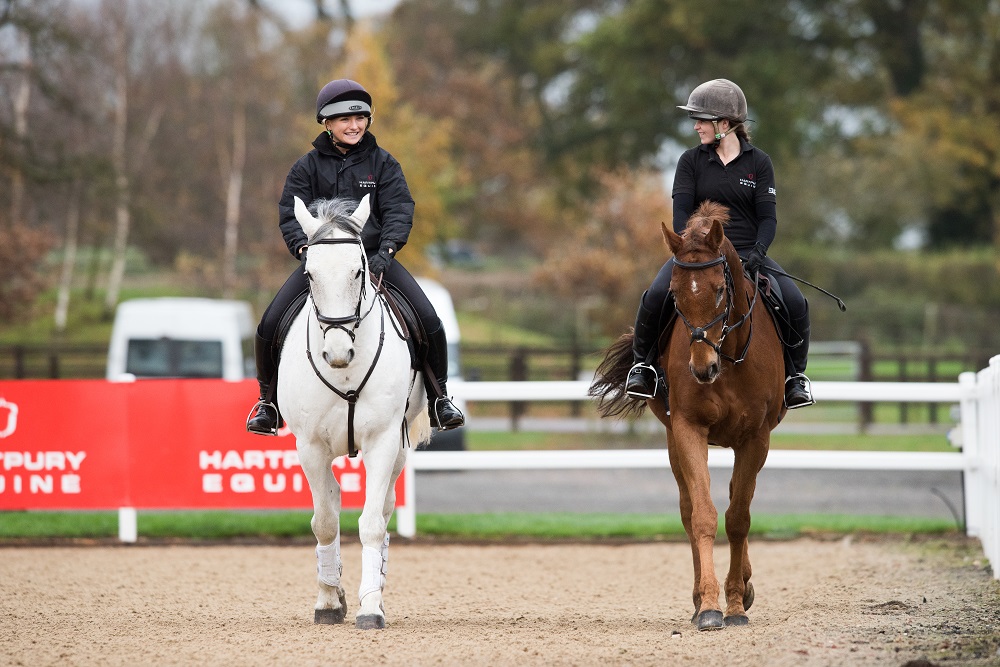Posted: 3rd November 2020 | Back to news feed

- Few comprehensive studies have been carried out about the benefits of warm-up exercises before competition and their impact on performance
- The purpose of this new study was to improve the understanding of what dressage and show jumping riders consider to be the benefits of performing particular warm-up exercises
- Approximately 50% of the riders surveyed believe that performing a horse’s usual warm-up routine before a competition has a positive effect on performance
Visit any equestrian competition and you’ll see riders and horses exercising carefully in preparation for the challenges ahead, but take a step back and you’ll find that the warm-up process poses plenty of questions.

What do riders regard as the benefits of warming up their horse? What is the optimum time for a warm-up? Is there any difference between a showjumping rider’s warm-up and a dressage rider’s warm-up? Does warming up positively affect performance for horse and rider?
To help provide some conclusive answers to benefit horse and rider, Associate Professor Dr Jane Williams from Hartpury University and Hartpury graduate Maud Chatel (BSc (Hons) Equine Science), founder and owner of France-based equine therapy company Rehactiv’Equine, carried out a preliminary study involving more than 250 riders.
Dr Williams, Head of Research at Hartpury University, said: “To ensure optimal performance, undertaking a warming-up regime before intense exercise is acknowledged as an effective way to lower the risk of injury and increase performance in human athletes.
“The same applies to equestrian sport, where it’s widely acknowledged that both the horse and rider should complete a pre-competition warm-up to prepare them for the demands of competition.
“The purpose of our study was to try and understand dressage and showjumping riders’ decision-making when warming up at home and prior to a competition.”
Previous studies have shown that an efficient warm-up regime will help to reduce lactic acid accumulation in the muscles, delaying the onset of fatigue and providing a potential performance advantage over horses which have not been warmed up adequately.
Before the study by Dr Williams and Ms Chatel, however, few had evaluated what constitutes an ‘ideal’ warm-up for different disciplines, horse experience, training level, fitness or how different environmental factors influence the warm-up.
The riders who took part in the study answered a range of questions, shared to selected French equine-related groups on Facebook, on an anonymous basis about their attitudes and approach to the warm-up process.
Dr Williams said: “Our study found that dressage and show jumpers maintain that warm-up regimes should prepare the horse for work, increase responsiveness to the riders’ aids, increase the horse’s suppleness and promote relaxation to enhance performance and decrease injury risk.
“Interestingly, warm-up duration used was similar for both dressage riders and show jumpers, averaging 10 to 20 minutes, though dressage riders used walk as their main warm-up gait, whilst show jumpers preferred trot.
“Across both disciplines, riders included technical skills in their warm-up such as lateral work, transitions and jumping.
“During a competition, approximately half of dressage and show jumpers surveyed agreed that using the horses’ usual warm-up routine was beneficial.”
Ms Chatel, whose business offers sports massage treatments for horses and riders of all levels across France, added: “Riders felt factors such as the stress level of both the horse and rider, crowdedness of the arena, arena size and surface as well as time allocated by the venue were important factors that could impact their warm-up routines.
“Both showjumpers and dressage riders considered horses were warmed up adequately using subjective measures likely to vary between riders: the horse’s responsive to the aids, when the horse felt supple and relaxed.
“Future research is warranted to investigate if rider recall of warm-up regimes matches the duration and activities included in these, in practice.”
Equine research students at Hartpury – the world’s largest equine educational establishment?–?have access to a wide range of state-of-the-art equipment and laboratories to support their studies.?
All research activity at Hartpury either directly or indirectly informs not only current industry practice but also the curriculum.? Research is fully integrated within teaching, with staff research active in the areas in which they?teach?and many dissertations embedded in larger scale research projects.?
Recent equine graduates from Hartpury, which offers a range of equine-related diplomas, undergraduate and postgraduate degrees, and PhDs, have embarked on careers with?a number of?major employers, including Cheltenham Racecourse, the Hong Kong Jockey Club and The Horse Trust.
The Equestrian Index newsfeed is compiled from articles submitted by advertising members and expresses the opinions of those members. Watsons Directories Ltd shall not be held liable for any inaccuracies or mis-statements therein.